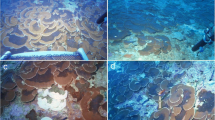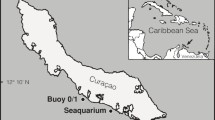Abstract
Depth distribution, zonation pattern and growth morphology of 17 hermatypic and 4 ahermatypic coral species were investigated at eight different locations along the Bermuda platform with the research submersible GEO and by SCUBA diving in August–September 1983. Hermatypic coral growth occurs to a depth of 50 to 70 m, with a single Montastrea cavernosa growing at 78 m. Dominant forms in shallow-water coral communities are Diploria sp. and Porites astreoides, while M. cavernosa, Agaricia fragilis and Scolymia cubensis occur in deep-water associations below 60 m. Vertical visibilities (up to 178 m) and distribution of the photosynthetically active radiation revealed good light penetration values (1% level at about 100 m depth), which should favour hermatypic coral growth to a much greater depth than it actually occurs. Nor should the prevailing temperatures limit the depth of coral growth. Most deep-water hermatypes observed grow on remnants of Pleistocene reefs down to about 60 m. The vast areas of large massed rhodolith nodules below 50 to 60 m are unsuitable bottom for coral colonisation. Macroalgae growth seems to be the strongest factor controlling coral growth in deep water. Bermuda stony corals have a low growth form diversity. Various intraspecific morphs may occur at the same as well as at different depths, with a general trend towards flatter shapes with depth. Comparison with a similar study on Red Sea corals suggests that annual distribution of radiant energy on the most northern Atlantic reefs of Bermuda may be responsible for the occurrence of flat and cuplike growth forms in relatively shallow water, and for the shallower depth limits of hermatypic growth.
Similar content being viewed by others
Literature cited
Barnes, D. J.: Growth in colonial scleractinians. Bull. mar. Sci. 23, 280–298 (1973)
Boardman, R.: Species diversity and composition of a southern Bermuda coral reef. Univ. Bridgeport mar. biol. Publ. 1, 36–48 (1978)
Boden, B. P. and E. M. Kampa: Winter cascading from an oceanic island and its biological implication. Nature, Lond. 171, 426 (1953)
Bradbury, R. H. and P. C. Young: Coral interaction and community structure: an analysis of spatial pattern. Mar. Ecol. Prog. Ser. 11, 265–271 (1983)
Cairns, S. D.: Stony corals (Cnidaria: Hydrozoa, Scleractinia) of Carrie Bow Cay, Belize. In: K. Rützler and I. A. MacIntyre (Eds.), The Atlantic Barrier Reef ecosystem at Carrie Bow Cay, Belize. In: Structure and communities, pp 271–302. Washington: Smithsonian Institution Press 1982
Clarke, G. L.: Light penetration in the Western North Atlantic and its application to biological problems. Rapp. P. V. Reun. Cons. int. Explor. Mer. 101, 3–14 (1936)
DeGhett, V. J.: Hierarchical cluster analysis. In: Colgan, R. W. (ed.) Quantitative Ethology, pp 115–144. New York: Wiley and Sons 1978
Dodge, R. E., A. Logan, and A. Antonius: Quantitative reef assessment studies in Bermuda: a comparison of methods and preliminary results. Bull. mar. Sci., 32, 745–760 (1982)
Dryer, S. and A. Logan: Holocene reefs and sediments of Castle Harbour, Bermuda. J. mar. Res. 36, 399–425 (1978)
Dustan, P.: Growth and form in the reef-building coral Montastrea annularis. Mar. Biol. 33, 101–107 (1975)
Dustan, P.: Distribution of zooxanthellae and photosynthetic chloroplast pigments of the reef-building coral Montastrea annularis (Ellis and Solander) in relation to depth on a West Indian coral reef. Bull. mar. Sci. 29, 79–95 (1979)
Focke, J. W. and C. D. Gebelein: Marine lithification of reef rock and rhodolites at a fore-reef slope locality off Bermuda. Geol. Mijnbouw 57, 163–171 (1978)
Foster, A. B.: Phenotypic plasticity in the reef coral Montastrea annularis (Ellis and Solander) and Siderastrea siderea (Ellis and Solander). J. exp. mar. Biol. Ecol. 39, 25–54 (1979)
Frazier, W. J.: Description of reefs in Castle Harbour, Bermuda. Spec. Publs. Berm. Biol. Stn. Res. 6, 63–72 (1970)
Fricke, H. W. and H. Schuhmacher: The depth limits of Red Sea stony corals: an ecophysiological problem (a deep diving survey by submersible). P.S.Z.N.I.: Mar. Ecol. 4, 163–194 (1983)
Garrett, P., D. L. Smith, A. O. Wilsop and D. Patriquin: Physiography ecology and sediments of two Bermuda patch reefs. J. Geol. 79, 647–668 (1971)
Goreau, T. F.: The ecology of Jamaican coral reefs. I. Species composition and zonation. Ecology 40, 67–90 (1959)
Goreau, T. F.: Wachstum und Kalkanlagerung bei Riffkorallen. Endeavour (Jan.), 32–39 (1961)
Goreau, T. F.: Calcium carbonate deposition by coralline algae and corals in relation to their roles as reef builders. N.Y. Acad. Sci. Ann. 109, 127–167 (1963)
Goreau, T. F. and D. Hartman: Boring sponges as controlling factors in the formation and maintenance of coral reefs. In: Mechanisms of hard tissue destruction, pp 25–54. Publication No. 75 of Am. Ass. Adv. Sci. Washington, D.C. 1963
Goreau, T. F. and J. W. Wells: The shallow-water Scleractinia of Jamaica: revised list of species and their vertical distribution range. Bull. mar. Sci. 17, 442–453 (1967)
Graus, R. R. and I. G. MacIntyre: Light control of growth form in colonial reef corals: computer simulation. Science, N.Y. 193, 895–897 (1976)
Graus, R. R. and I. G. MacIntyre: Variation in growth forms of the reef coral Montastrea annularis (Ellis and Solander): a quantitative evaluation of growth response to light distribution using computer simulation. In: The Atlantic Barrier Reef ecosystem at Carrie Bow Cay, Belize, I: Structure and communities. Ed. by K. Rützler and G. MacIntyre. Smithson. Contrib. mar. Sci. 12, 441–464 (1982)
Ivanoff, A., Jerlov, N. and T. H. Waterman: A comparative study of irradiance, beam transmittance and scattering in the sea near Bermuda. Limnol. Oceanogr. 6, 129–148 (1961)
James, N. P. and R. G. Ginsburg: The seaward margin of Belize barrier and atoll reefs. Int. Ass. Sediment. Spec. Publ. 3, 1–191 (1979)
Jaubert, J.: Light, metabolism and growth forms of the hermatypic scleractinian coral Synaraea convexa Verrill in the lagoon of Moorea (French Polynesia). Proc. Third Int. Coral Reef Symp. Miami 1, 483–488 (1977)
Johannes, R. E., W. J. Wiebe, C. J. Crossland, D. W. Rimmer and S. V. Smith: Latitutinal limits of coral reef growth. Mar. Ecol. Prog. Ser. 11, 105–111 (1983)
Kühlmann, D.: Zusammensetzung und Ökologie von Tiefwasserkorallen-assoziationen. Wiss. Zeitsch. Humboldt-Universität Berlin, Math.-Nat. R. XXXI (3), 233–243 (1982)
Lang, J.: Interspecific aggression by scleractinian corals. 2. Why the race is not only to the swift. Bull. mar. Sci. 23, 260–279 (1973)
Lang, J.: Biological zonation at the base of a reef. Am. Sci. 62, 272–281 (1974)
Logan, A.: Interspecific aggression in hermatypic corals from Bermuda. Coral Reefs 3, 131–138 (1984)
Loya, Y.: Community structure and species diversity of hermatypic corals at Eilat, Red Sea. Mar. Biol. 13, 100–123 (1972)
Mayor, A. G.: The effects of temperature on tropical marine animals. Carnegie Inst. Pub. 183, 1–124 (1914)
Mayor, A. G.: The lower temperature at which reef-corals lose their ability to capture food. Yearbook. Carnegie Inst. Washington, D.C. 14, 212 (1915)
Meischner, D. and U. Meischner: Bermuda South Shore Reef Morphology. A preliminary report, Vol. 2, pp 243–250: Miami: Proc. Third Int. Coral Reef Symp. 1977
Morris, B., J. Barnes, F. Brown and J. Markham: The Bermuda marine environment. Bermuda Biol. Sta. Spec. Publ. 15, 1–120 (1977)
Porter, J. W.: Autotrophy, heterotrophy, and resource partitioning in Caribbean reef-building corals. Am. Nat. 110, 731–742 (1976)
Rinkevich, B. and Y. Loya: Intraspecific competitive networks in the Red Sea coral Stylophora pistillata. Coral Reefs 1, 161–172 (1983)
Roberts, H. H., L. J. Rouse, N. D. Walker and J. H. Hudson: Cold water stress in Florida Bay and Northern Bahamas: a product of winter cold-air outbreaks. J. Sediment. Petrol. 52, 145–155 (1982)
Roos, P. J.: Growth and the occurrence of the reef coral Porites astreoides Lamarck in relation to submarine radiance distribution. Dissertation, Utrecht 1967
Sheppard, C. R. C.: Coral cover, zonation and diversity of reef slopes of Chagos Atolls, and population structures of the major species. Mar. Ecol. Prog. Ser. 2, 193–205 (1980)
Shinn, E. A.: Coral growth rate, an environmental indicator. J. Palaeontol. 40, 233–240 (1966)
Siegel, S.: Nonparametric statistics, 312 pp. Kogakusha: McGraw Hill 1956
Sokal, R. R. and P. H. Sneath: Principles of numerical taxonomy, 359 pp. San Francisco and London, W. H. Freeman Co., 1963
Stanley, D. J. and J. P. Swift: Bermudas reef-front platform: bathymetry and significance. Mar. Geol. 6, 479–500 (1968)
Verrill, A. E.: Additions to the Anthozoa and Hydrozoa of the Bermudas. Trans. Connecticut Acad. Arts Sci. 10, 551–572 (1900)
Verrill, A. E.: Variations and nomenclature of Bermudian, West Indian and Brazilian reef corals with notes on various Indopacific corals. Trans. Connecticut Acad. Arts Sci. 11, 63–168 (1901a)
Verrill, A. E.: Comparison of the Bermudian, West Indian and Brazilian coral faunae. Trans. Connecticut Acad. Arts Sci., 11, 169–206 (1901b)
Vaughan, T. W.: Corals and the formation of coral reefs. Ann. Rept. Smithsonian Inst. 17, 189–238 (1919)
Yamazato, K.: Bathymetric distribution of corals in the Ryukyu Islands. Proc. Symp. Corals and Coral Reefs, 1969. Mar. Biol. Ass. India, 121–133 (1972)
Zar, J. H.: Biostatistical analysis 620 pp. Englewood Cliffs, New Jersey: Prentice Hall, Inc. 1974
Author information
Authors and Affiliations
Additional information
Communicated by O. Kinne, Oldendorf/Luhe
Rights and permissions
About this article
Cite this article
Fricke, H., Meischner, D. Depth limits of Bermudan scleractinian corals: a submersible survey. Mar. Biol. 88, 175–187 (1985). https://doi.org/10.1007/BF00397165
Accepted:
Issue Date:
DOI: https://doi.org/10.1007/BF00397165




